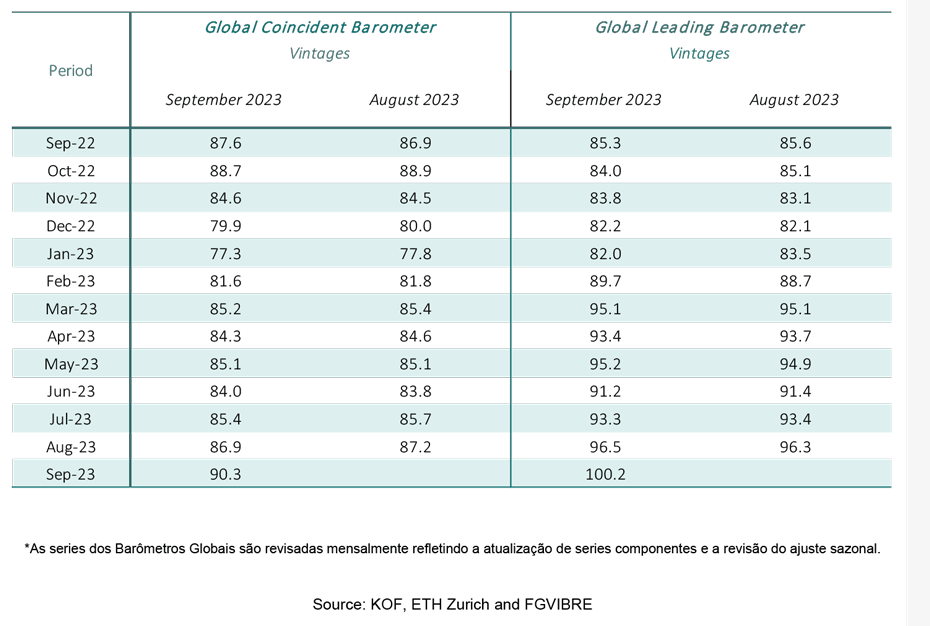Global Barometers point to improving conditions
The Global Barometers rise in all regions for the third consecutive month in September. Although still below average, the Coincident Barometer shows some improvement in overall economic conditions, while the Leading Barometer reaches its historical average of 100 points.
The Coincident Global Economic Barometer increases by 3.4 points in September to 90.3 points, its highest level since July 2022 (91.1 pts.), while the Leading Economic Barometer rises by 3.7 points to 100.2 points, its highest level since October 2021 (101.1 pts.). In both cases, the results were driven by gains in all three regions analysed, with the strongest contribution coming from the Asia, Pacific & Africa region.
“The light at the end of the current stagnation tunnel is beginning to appear. After almost two years of below-average readings, the leading version of the global barometer has returned to its long-term average. However, the assessment of the current situation is still one standard deviation below the average. So global growth remains subdued, but barring new negative shocks to the global economy or major parts of it, the cyclical trough is increasingly likely to be behind us. With inflation falling, the soft-landing scenario in the back of the minds of many central bankers around the world appears to be materialising. Let us hope that this assessment remains valid in the coming months”, evaluates Jan-Egbert Sturm, Director of KOF Swiss Economic Institute.

“With inflation falling, the soft-landing scenario in the back of the minds of many central bankers around the world appears to be materialising. Let us hope that this assessment remains valid in the coming months.”Jan-Egbert Sturm, Director of KOF Swiss Economic Institute
Coincident Barometer – regions and sectors
After a period of relative stability in the previous months, the Coincident Barometer accelerates in September. The largest contribution to the increase comes from the Asia, Pacific & Africa region with 2.2 points, followed by the Western Hemisphere and Europe, with 0.9 and 0.3 points, respectively. The Coincident indicator for the Asia, Pacific & Africa region remains the highest among the regions, although the Western Hemisphere shows the largest increase for the year with a rise of 13.5 points. The graph below shows the contribution of each region to the deviation of the Coincident Barometer from its historical average of 100 points.
All of the Coincident sector indicators rise this month, the most notable being that for Industry, which approaches the 90-point level. The indicators for the Economy (aggregated business and consumer evaluations), Trade, and Services show similar increases, while the Construction sector records the lowest increase for the month.
Leading Barometer – regions and sectors
On average, the Leading Global Barometer leads the world economic growth rate cycle by three to six months. In September, the regional contributions follow the pattern of the Coincident indicator, with the Asia, Pacific & Africa region contributing 1.6 points, followed by the Western Hemisphere and Europe, with 1.4 and 0.7 points, respectively. The level of the indicators suggests a more widespread perception of an increased growth rate in the main regions, with the Asia, Pacific & Africa region approaching the neutral level of 100 points.
The Leading sector indicators for Construction, Industry, Trade, and the Economy (aggregated business and consumer assessments) rose in September, while Services fell after strong increases in July and August. Despite the decline, Services remains the sector with the highest level. Only the Industry indicator is still below the neutral level of 100 points.
The Global Economic Barometers
The Global Economic Barometers are a system of indicators enabling timely analysis of global economic development. They represent a collaboration between the KOF Swiss Economic Institute of the ETH Zurich in Switzerland and Fundação Getulio Vargas (FGV), based in Rio de Janeiro, Brazil. The system consists of two composite indicators, the Coincident Barometer and the Leading Barometer. The Coincident Barometer reflects the current state of economic activity, while the Leading Barometer provides a cyclical signal roughly six months ahead of current economic developments.
The two Barometers comprise the results of economic tendency surveys conducted in more than 50 countries with the aim of achieving the broadest possible global coverage. The advantages of economic tendency surveys are that their results are usually readily available and are not substantially revised after first publication.
The Coincident Barometer includes more than 1,000 different time series, while the Leading Barometer consists of over 600 time series. Cross-correlation analysis is used to decide which individual time series are included in the barometers. This involves correlating the individual time series with a reference series. The reference series used is the year-on-year growth rate of global gross domestic product (GDP), where the individual national GDPs are aggregated at purchasing power parity to form global GDP. A time series is only included in a Barometer if it shows a sufficiently high correlation and a suitable synchronization or lead with the reference series. The time period used for this correlation analysis currently runs from January 2010 to December 2019.
The series of the two Barometers are revised each month at publication and are standardized to have a mean of 100 and a standard deviation of 10 for the 10-year period previous to the most recent observations.
The methodology is described in:
Klaus Abberger, Michael Graff, Aloisio Jr. Campelo, Anna Carolina Lemos Gouveia, Oliver Müller and Jan-Egbert Sturm (2020), The Global Economic Barometers: Composite indicators for the world economy. KOF Working Papers, vol. 471, Zurich: KOF Swiss Economic Institute, ETH Zurich, 2020.
Contact
KOF Konjunkturforschungsstelle
Leonhardstrasse 21
8092
Zürich
Switzerland


